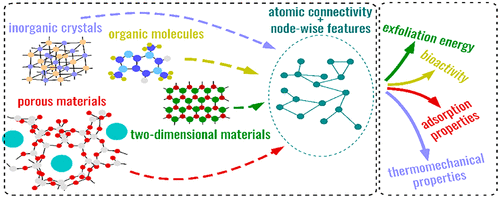当前位置:
X-MOL 学术
›
J. Chem. Inf. Model.
›
论文详情
Our official English website, www.x-mol.net, welcomes your
feedback! (Note: you will need to create a separate account there.)
Graph Convolutional Neural Networks as "General-Purpose" Property Predictors: The Universality and Limits of Applicability.
Journal of Chemical Information and Modeling ( IF 5.6 ) Pub Date : 2020-01-03 , DOI: 10.1021/acs.jcim.9b00587 Vadim Korolev 1, 2 , Artem Mitrofanov 1, 2 , Alexandru Korotcov 1 , Valery Tkachenko 1
Journal of Chemical Information and Modeling ( IF 5.6 ) Pub Date : 2020-01-03 , DOI: 10.1021/acs.jcim.9b00587 Vadim Korolev 1, 2 , Artem Mitrofanov 1, 2 , Alexandru Korotcov 1 , Valery Tkachenko 1
Affiliation

|
Nowadays the development of new functional materials/chemical compounds using machine learning (ML) techniques is a hot topic and includes several crucial steps, one of which is the choice of chemical structure representation. The classical approach of rigorous feature engineering in ML typically improves the performance of the predictive model, but at the same time, it narrows down the scope of applicability and decreases the physical interpretability of predicted results. In this study, we present graph convolutional neural networks (GCNNs) as an architecture that allows for successfully predicting the properties of compounds from diverse domains of chemical space, using a minimal set of meaningful descriptors. The applicability of GCNN models has been demonstrated by a wide range of chemical domain-specific properties. Their performance is comparable to state-of-the-art techniques; however, this architecture exempts from the need to carry out precise feature engineering.
中文翻译:

图卷积神经网络作为“通用”属性预测器:适用性的普遍性和局限性。
如今,使用机器学习(ML)技术开发新的功能材料/化合物是一个热门话题,其中包括几个关键步骤,其中之一是选择化学结构表示形式。机器学习中严格的特征工程的经典方法通常可以提高预测模型的性能,但是同时,它缩小了适用范围,并降低了预测结果的物理可解释性。在这项研究中,我们提出了图卷积神经网络(GCNN)作为一种体系结构,它使用最少的一组有意义的描述符就可以成功地预测化学空间各个领域的化合物的特性。GCNN模型的适用性已通过广泛的化学领域特定特性得到证明。它们的性能可与最新技术相媲美。但是,该体系结构无需进行精确的特征工程。
更新日期:2020-01-04
中文翻译:

图卷积神经网络作为“通用”属性预测器:适用性的普遍性和局限性。
如今,使用机器学习(ML)技术开发新的功能材料/化合物是一个热门话题,其中包括几个关键步骤,其中之一是选择化学结构表示形式。机器学习中严格的特征工程的经典方法通常可以提高预测模型的性能,但是同时,它缩小了适用范围,并降低了预测结果的物理可解释性。在这项研究中,我们提出了图卷积神经网络(GCNN)作为一种体系结构,它使用最少的一组有意义的描述符就可以成功地预测化学空间各个领域的化合物的特性。GCNN模型的适用性已通过广泛的化学领域特定特性得到证明。它们的性能可与最新技术相媲美。但是,该体系结构无需进行精确的特征工程。











































 京公网安备 11010802027423号
京公网安备 11010802027423号